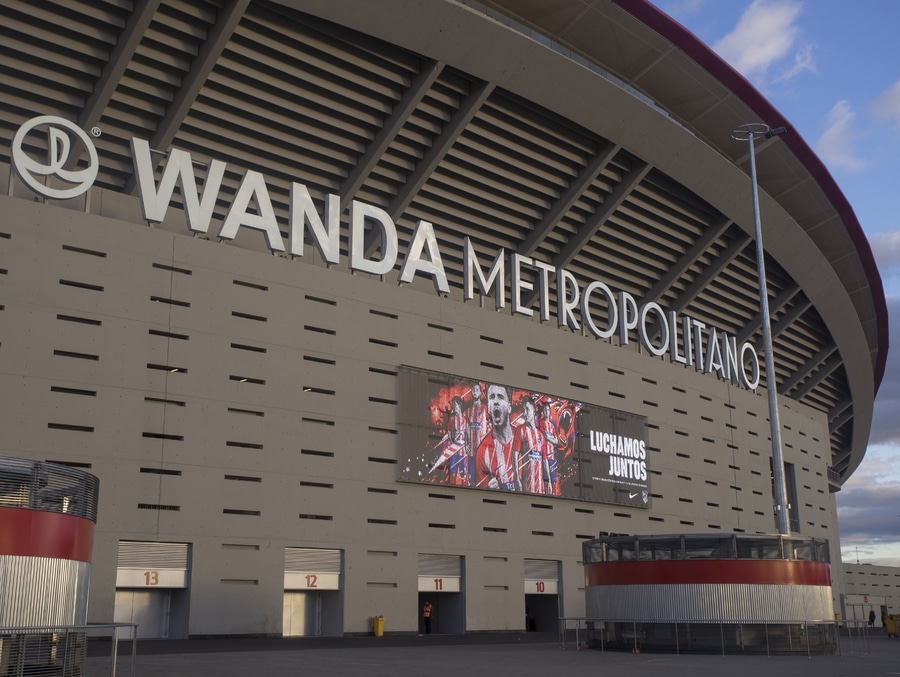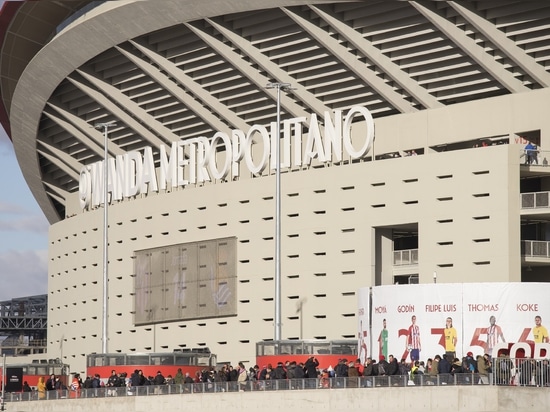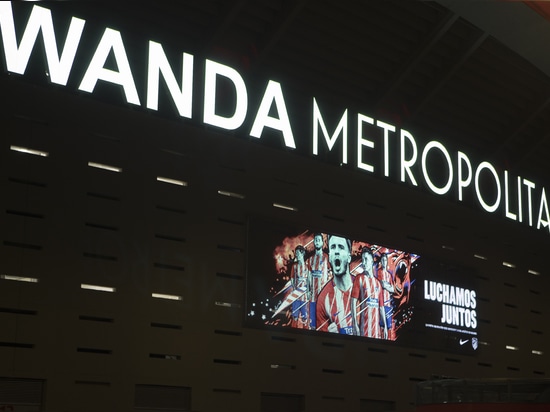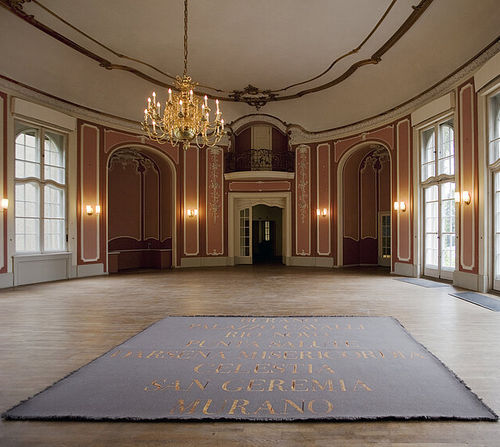
#Product Trends
Transparent media façade for Atlético Madrid
Stadium of superlatives impresses with emotion and convenience
Bigger, more convenient, more spectacular: the new stadium of the top Spanish club Atlético Madrid is among the very elite of European soccer arenas. After six years in construction, the tradition-steeped club opened the doors of the Estadio Wanda Metropolitano in the north-east of the Spanish capital. A large screen on the western façade above the main entrance gets arriving fans in the mood for the match ahead with video sequences from previous games and emotional images. Yet the transparent MEDIAMESH® system from GKD – Gebr. Kufferath AG (GKD) nevertheless blends in perfectly with the puristic façade design. As a result, the spectacularly sweeping roof with integrated LED bands, the bright, horizontally perforated façade and the MEDIAMESH® display all blend in together perfectly.
Close to Madrid Barajas International Airport and in the immediate vicinity of the M-40 highway, Madrid's new landmark rises into the sky in the form of the Estadio Wanda Metropolitano. Cruz y Ortiz Arquitectos designed the arena spanning 88,000 square meters on the site of the Estadio de La Peineta in the suburb of San Blas-Canillejas – one of the city's most important growth districts. The stadium, built in 1994 and originally intended for the World Athletics Championships, was long planned as the venue for the Olympic Games in Madrid. As early as 2007 the city council reached an agreement with Atlético that the club would move from the famous Estadio Vicente Calderón to the Estadio de La Peineta for the 2017/18 season. After all, it has long been apparent that the arena in the south-west of Madrid, which had been used for more than 50 years, would not be able to meet the growing requirements of modern stadium design due to its topographical location on the Manzanares river. Neither expansion nor modernization was possible to the necessary degree. In 2011, Cruz y Ortiz Arquitectos presented their first plans to refurbish the Estadio de La Peineta, which at that time held only 20,500 spectators, as a stadium for both athletics and soccer. When the city of Madrid failed to win the Olympic Games for the third time, however, this project was permanently abandoned. Instead, 300 million euros were invested to create a pure soccer stadium accommodating 68,000 spectators.
Dawning of an era
Under a new name this stadium was handed over in time for the start of the 2017/18 season. Atlético replaced the previous name La Peineta – a reference to the main stand's similarity to a comb – with Wanda Metropolitano. With this, the club combined the name of its Chinese sponsor Wanda Group with a reminder of the Estadio Metropolitano, the club's home from 1923 to 1966. Only the imposing main stand of the old stadium was retained. In contrast to the previous home stadium of Atlético, the Estadio Vicente Calderón, the Estadio Wanda Metropolitano located around 20 kilometers further east meets the highest standards in terms of convenience, safety and sight lines. This puts it among the very elite of European soccer stadia. A significantly greater gap between rows enables fans to reach their seat without any hassle. To allow this, the theoretically possible capacity of 73,000 was reduced to 68,000 – 12,000 more than in the Estadio Vicente Calderón. The stands, which extend all the way to the sidelines, are fitted with seats in the club's colors of red and white. Clearly structured areas optimally guide the flow of spectators. Shops and gastronomic offerings were designed in such a way that they are also accessible from outside. Moreover, all entrances and emergency exit routes were designed in line with state-of-the-art concepts. One example of this are the dedicated elevators for each individual area and convenient entrances with disabled access. Another convenience-boosting factor for the visitors is the total of 3,000 parking spaces around the stadium as well as a further 1,000 in the underground parking garage under the arena. The gigantic spoked-wheel membrane roof with integrated LEDs protects virtually all seats – only 300 seats are left uncovered. At the same time its spectacular design organically combines new and old parts of the building. Viewed from the inside, the roof is reminiscent of the Maracanã Stadium in Rio, while from the outside its colorful illumination is similar to that of the Allianz Arena in Munich.
Brilliant images to greet visitors
With the installation of a transparent media façade spanning almost 150 square meters on the outer wall of the main stand, Atlético Madrid emphasizes the superlative nature of the stadium. The first MEDIAMESH® system in Spain puts the Estadio Wanda Metropolitano in the same league as famous structures all over the world – including the most prominent pioneer in stadium construction, the American Airlines Arena of NBA basketball team Miami Heat in the USA. When switched off, the transparent stainless steel mesh with integrated LED profiles melts into the architecture of the striking western façade. This effect is supported by the virtually invisible cabling and filigree substructure of the large woven display. With a vertical and horizontal spacing of five centimeters between the LEDs, the switched-on screen boasts a brilliant reproduction of images, videos or live streams around the clock. The visually seamless screen is made up of six mesh panels, each measuring six meters high and four meters wide, meeting the client's highly stringent requirements with regard to aesthetics, functionality and energy efficiency. Alongside its technical brilliance and attractive appearance, the screen's robust weather resistance and freedom from maintenance also counted in its favor. Furthermore, because the heat-
and cold-resistant system does not require external cooling, MEDIAMESH® is highly economical when it comes to energy consumption. This extraordinary spectrum of qualities allows the famous top-flight club to give its fans an emotional experience that is totally unique in Spain to date upon their arrival at the stadium.
Fit for the Champions League
The stadium did not have to wait long to score its first major success: just a few days after it was opened, the European soccer governing body UEFA awarded the Champions League final to the Estadio Wanda Metropolitano. Atlético Madrid will therefore host the final of the continent's top club competition on June 1, 2019 – an event that last took place in Spain at the Santiago Bernabéu stadium of local rivals Real Madrid in 2010. The spectators at the Champions League final will then enjoy a fitting welcome from the imposing MEDIAMESH® screen from GKD.







